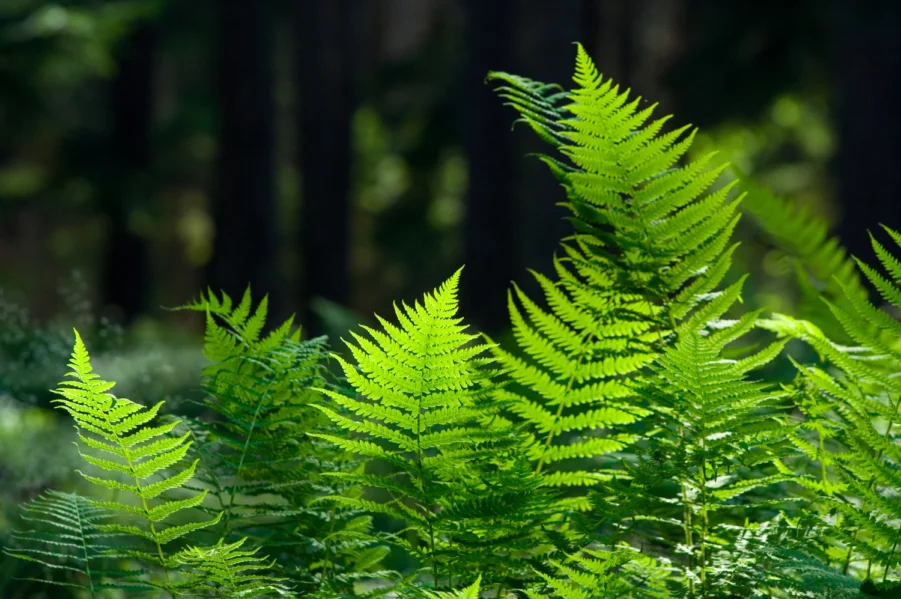Just like mosses, ferns are another widespread part of the wall of green people encounter in the outdoors. They’re found all over the world, but often blend into the background and fall beneath our notice. Ferns don’t grow like wildflowers and trees, and have some cool traits that set them apart from other vegetation. For this Wildlife Spotlight, I’d like to take a closer look at ferns and what makes them special.
Are ferns plants?
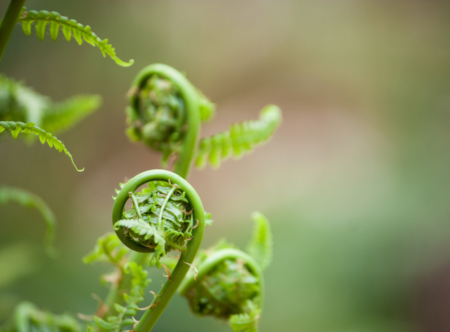
One of the first questions I tend to get from people about ferns is whether or not they are plants. While this may seem silly at first, it’s a sensible question. They’re green like other plant, but differ in other ways (why are plants green? Check out this post to find out!). Ferns lack a lot of common characteristics that are typical of the majority of the plants we encounter. They don’t have:
- Seeds
- Fruits
- Flowers
Despite these differences, ferns are plants. They’re just a very different kind of plant than what many of us are used to. Next time you come across a fern, don’t miss the chance for a closer look! Check out my guide to using a magnifying glass for more.
Spanning the gap
Not having flowers or seeds makes ferns a lot more like mosses (to learn more about mosses, check out this post!). As it turns out, both mosses and ferns are also plants, but ferns are a step between mosses and seed-producing plants. Importantly, ferns have vascular tissue, which enables them to move water, sugar, hormones, nutrients, and other substances through their bodies. The result? Ferns can get a lot bigger than mosses. While the tallest mosses might reach 20 inches (50cm) in height, some tree ferns can get over 65 feet (20m)! In this way, ferns are similar in stature to most everyday seed-bearing plants, although most of them aren’t as big as trees.
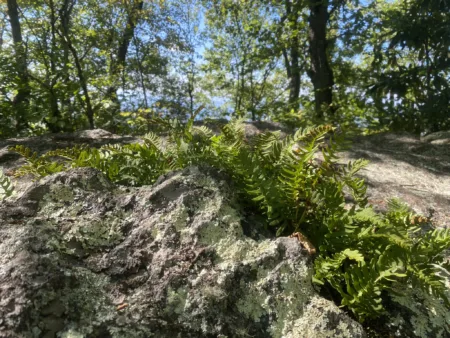
The similarities to seed-bearing plants don’t end there. In fact, ferns have other characteristics that we might recognize from more familiar plants. For example, they often have:
- Distinct leaves with petioles (leaf stems)
- Rhizomes
- Roots
Check out the next section for more on these parts and how they help ferns survive.
Characteristics of ferns
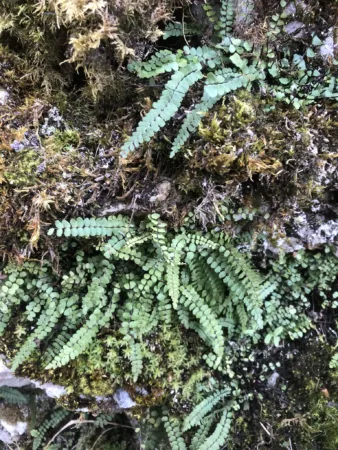
These fascinating plants are extremely diverse, with over 10,000 described species! Only a few hundred belong to a group called the Eusporangiates. These include plants like horsetails (Equisetum), and groups like the moonworts (Ophioglossales) and marrattoid ferns. You probably haven’t encountered Eusporangiates unless you know where to look. One possible exception is the horsetails, which occur in many wetland and riverside areas. I have run across them in my wetland adventures in Montana and Georgia.
By contrast, more than 80% of fern species belong to a group called the Leptosporangiates. The difference between these groups is based on how their spores develop; whether its from one single cell or several. However, they differ markedly in appearance. Generally, nearly every fern you’ll find belongs to this latter group, also named the Polypodiidae. Within this subclass, the vast majority of species belong to the order Polypodiales. Confused by all this classification talk? Check out my gentle introduction to taxonomy.
Considering all that, we can focus on some of the common traits of the most widespread fern group, the Polypodiales. These typically consist of:
- A rhizome or main body, which is often concealed beneath the ground. In such cases, scientists call it a lateral root. For tree-like Polypodiales, it acts like a trunk and is vertical.
- Leaves, which are often feather-like in appearance.
- Tiny roots, typically much smaller and finer than the roots of seed plants.
Mostly leaves
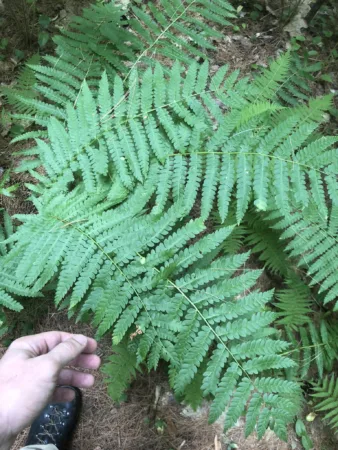
Most of what we see of ferns is their leaves, also known as fronds. Fronds behave similarly to the leaves of other plants. They are the main site of photosynthesis. In addition, they support the fern’s reproductive structures. Fronds can be quite large in size, typically much larger than the leaves of seed plants.
Fronds are usually long and feather-like, with a central axis and lots of leaflets coming off at right angles. Scientists have a whole vocabulary for describing the different parts of a frond:
- Rachis – the main “stem” or central axis
- Pinnae (singular pinna) – the leaflets branching off from the rachis
- Pinnules – leaflets of the leaflets; secondary divisions of the frond
- Stipe – the portion of the frond with no pinnae, also known as the petiole
- Blade – the portion of the frond with pinnae
- Apex – the tip of the frond
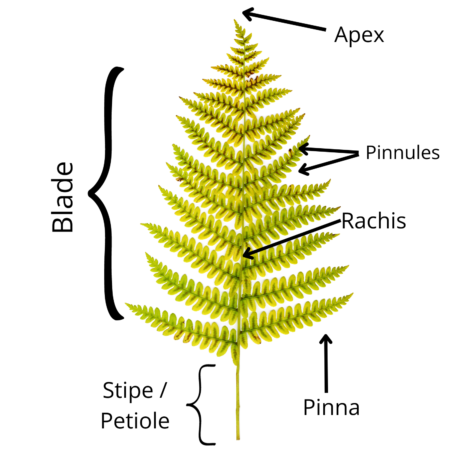
Although it’s a bit of a mouthful, these specialized words can help you describe ferns you encounter in your outdoor adventures. They’ll be important for reading and interpreting field guides, for instance, or communicating with other nature enthusiasts. It will also help you identify and remember key characteristics of species you spotted, like using field marks for identifying birds.
No Flowers? No Problem!
Flowers are the primary way that seed plants reproduce. However, like mosses, ferns use another strategy. Specifically, they reproduce by producing spores. These tiny cells can travel huge distances by wind because of their miniscule size. When they reach a good microhabitat for growth, they can start developing into a plant. This is why you’ll occasionally find ferns in hard-to-reach places like clifftops or high up in trees or buildings.
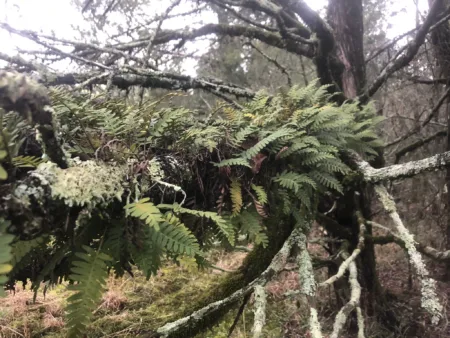
Structures called sporangia, sometimes arranged into clusters called sori produce these spores on the plant. In many fern species, you’ll find these under the individual leaflets or pinnules of the fern leaf. Only certain fronds have sori, though. On some species, these will appear different than the rest of the fronts, often standing taller than the rest. This helps the spores disperse better. Botanists call spore-bearing fronds fertile fronds or sporophylls (literally fern-leaf). Meanwhile, fronds without sori are called interfile fronds or tropophylls.
The leafy fern plant producing spores is called the sporophyte form of the plant. As with moss sporophytes, it has two copies of fern DNA, one from each of its parents. Each of its spores has only one copy, however.
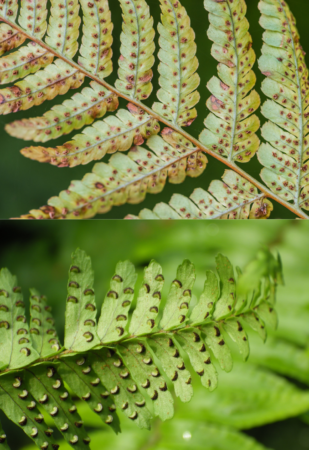
When the spores germinate, they develop into the gametophyte form via cellular division. For most ferns you’re likely to meet in the wild, this form looks like a tiny green heart. It’s easy to miss, and may be hidden amongst nearby sporophytes. The gametophytes produce the fern’s sexual organs: sometimes male, sometimes, female, sometimes both. Motile, swimming sperm fertilize the gametophyte’s eggs, and produce a new sporophyte embryo. As it grows into a mature sporophyte, this plant might overshadow or conceal, or even contain the gametophyte.
Ancient plants
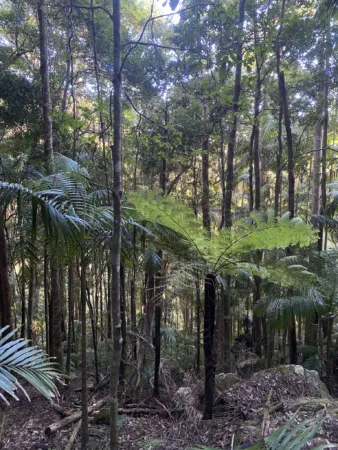
As you might have guessed from their weird way of doing things, ferns are ancient plants. Again, this is just like the mosses. In fact, ferns are intermediate in age between mosses and seeded plants, just like their characteristics. While mosses were the first land plants ~450 million years ago, ferns showed up somewhere around 360 million years ago. They’re no spring chickens, though: that still means that ferns existed for a good 10 million years before land-dwelling vertebrates came on the scene!
Where can you find ferns?
Because they start their lives as tiny spores, ferns, like mosses, can pop up all over the place. If conditions are right, they will show up sooner or later! Having vascular tissue ,ferns are somewhat less dependent on loads of ambient water than mosses are. Nonetheless, they are most common in wetter areas.
Over one third of polypode ferns are epiphytes, living their whole lives in trees and never touching the ground. The huge amount of moisture and great growing conditions in tropical rainforests makes them awesome places to find ferns. You can find hundreds, even thousands of fern species in tropical parts of Asia, Africa, and the Americas. However, you might encounter a fern or two nearly anywhere: there are species native to the Arctic and Antarctic as well!

Want to learn more about ferns?
The American Fern Society is a great resource with tons of research and extra information. Bob and Bill from The Nature Guys Podcast also did a great episode on them, which you can check out below.
Thanks for reading!
Do you have a local favorite fern species? Share with us in the comments! If you enjoyed this post, please support Gulo in Nature by sharing with a friend and following on Social Media.

